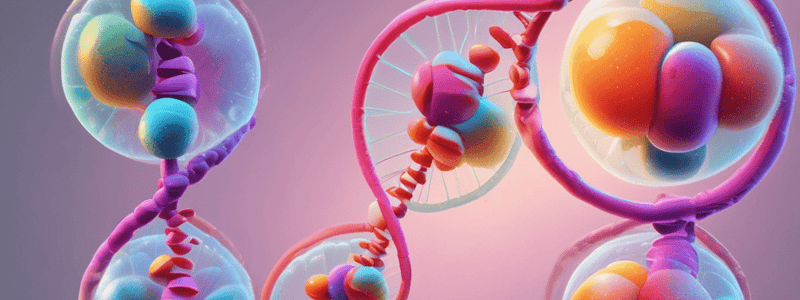Podcast
Questions and Answers
What is the DNA content of cells at the end of the S phase if they started with an average of 8 picograms of DNA per nucleus?
What is the DNA content of cells at the end of the S phase if they started with an average of 8 picograms of DNA per nucleus?
- 8 picograms
- 4 picograms
- 12 picograms
- 16 picograms (correct)
Which process do somatic cells derived from a single-celled zygote primarily use for division?
Which process do somatic cells derived from a single-celled zygote primarily use for division?
- Cytokinesis alone
- Meiosis
- Binary fission
- Replication (correct)
What stage of mitosis is indicated when replicated chromosomes are aligned along the center (equator) of a cell in onion root tip cells?
What stage of mitosis is indicated when replicated chromosomes are aligned along the center (equator) of a cell in onion root tip cells?
- Prophase
- Telophase
- Anaphase
- Prometaphase (correct)
In mitosis, what event must occur for anaphase to begin?
In mitosis, what event must occur for anaphase to begin?
Why do chromosomes coil during mitosis?
Why do chromosomes coil during mitosis?
During which phase of the cell cycle does DNA replication occur?
During which phase of the cell cycle does DNA replication occur?
What is the role of kinetochores during mitosis?
What is the role of kinetochores during mitosis?
During which phase of the cell cycle is DNA replicated?
During which phase of the cell cycle is DNA replicated?
At which point in the cell cycle does the 'restriction point' occur?
At which point in the cell cycle does the 'restriction point' occur?
In which phase of the cell cycle are nerve and muscle cells typically found?
In which phase of the cell cycle are nerve and muscle cells typically found?
What is the phase where cells exit the cell cycle and enter a nondividing state?
What is the phase where cells exit the cell cycle and enter a nondividing state?
What would likely happen if a cell no longer produces a normal protein kinase for the M phase checkpoint?
What would likely happen if a cell no longer produces a normal protein kinase for the M phase checkpoint?
How is density-dependent inhibition explained?
How is density-dependent inhibition explained?
What is a possible consequence of cancer cells not exhibiting density-dependent inhibition?
What is a possible consequence of cancer cells not exhibiting density-dependent inhibition?
How might cells with mutated checkpoint proteins behave during the cell cycle?
How might cells with mutated checkpoint proteins behave during the cell cycle?
If a cell fails to enter prophase, what could be the next outcome?
If a cell fails to enter prophase, what could be the next outcome?
How do cells usually respond when they have lost key regulatory proteins for mitosis?
How do cells usually respond when they have lost key regulatory proteins for mitosis?
Which statement most accurately explains why cells from an advanced malignant tumor often have abnormal chromosomes?
Which statement most accurately explains why cells from an advanced malignant tumor often have abnormal chromosomes?
In addition to the overproliferation of cancer cells, what else could potentially result in the formation of a tumor?
In addition to the overproliferation of cancer cells, what else could potentially result in the formation of a tumor?
Why are elderly donor samples often stated to represent cells incapable of cell division?
Why are elderly donor samples often stated to represent cells incapable of cell division?
What characteristic distinguishes chromosomally abnormal cells in tumors from normal cells regarding metabolism?
What characteristic distinguishes chromosomally abnormal cells in tumors from normal cells regarding metabolism?
What effect does the introduction of new chromosomes through transformation have on cancer cells?
What effect does the introduction of new chromosomes through transformation have on cancer cells?
Which factor primarily contributes to the inability of some cancer cells to anchor and divide normally?
Which factor primarily contributes to the inability of some cancer cells to anchor and divide normally?
What is a common characteristic of chromosomally abnormal cancer cells that distinguishes them from normal cells regarding their division requirements?
What is a common characteristic of chromosomally abnormal cancer cells that distinguishes them from normal cells regarding their division requirements?
What is the main reason why chromosomes move toward the poles of the spindle during mitosis?
What is the main reason why chromosomes move toward the poles of the spindle during mitosis?
Which statement accurately describes chromosomes moving toward the poles of the spindle during mitosis?
Which statement accurately describes chromosomes moving toward the poles of the spindle during mitosis?
What distinguishes chromosomes that move towards the poles of the spindle during mitosis?
What distinguishes chromosomes that move towards the poles of the spindle during mitosis?
Which function do spindle microtubules that do not attach to kinetochores serve during mitosis?
Which function do spindle microtubules that do not attach to kinetochores serve during mitosis?
In mitosis, what role do motor proteins play in chromosome movement?
In mitosis, what role do motor proteins play in chromosome movement?
Which statement accurately reflects the process of chromosome movement during mitosis?
Which statement accurately reflects the process of chromosome movement during mitosis?
What distinguishes chromosomes with non-kinetochore spindle fibers during mitosis?
What distinguishes chromosomes with non-kinetochore spindle fibers during mitosis?
Flashcards are hidden until you start studying




